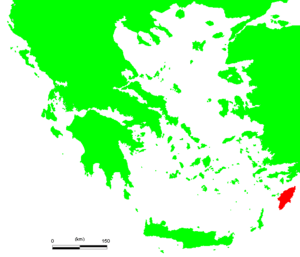Operation Anglo facts for kids
Quick facts for kids Operation Anglo |
|||||||
|---|---|---|---|---|---|---|---|
| Part of the Mediterranean and Middle East theatre of the Second World War | |||||||
 Map of Greece, the Greek Islands and Turkey Rhodes is highlighted in red |
|||||||
|
|||||||
| Belligerents | |||||||
| Commanders and leaders | |||||||
| Units involved | |||||||
| Special Boat Section (SBS) | |||||||
| Strength | |||||||
| 8 British Commandos 4 Greeks |
30,000 garrison | ||||||
| Casualties and losses | |||||||
| 10 captured | At least 33 aircraft destroyed and some fuel supplies | ||||||
Operation Anglo was a secret mission by British Commandos during World War II. It took place on the island of Rhodes in September 1942. A small team of eight British soldiers from the Special Boat Section (SBS) and four Greek helpers carried out the raid.
Their goal was to attack two airfields on Rhodes. These airfields were being used by German and Italian planes. These planes were bombing Royal Navy ships. After the attack, the team planned to return to a beach. A submarine would then pick them up.
Only two SBS soldiers made it back to the beach. They had to hide for four days. After this mission, the SBS group joined the Special Air Service. This was because they had lost so many men. In 1954, a movie called They Who Dare was made about this raid.
Contents
Why the Mission Happened
By 1942, a special British unit called No. 1 Special Boat Section was in the Middle East. They were part of the Special Air Service (SAS). They used small, foldable canoes for their missions. In July 1942, they attacked airfields on the island of Crete.
Now, their new mission was to attack airfields on Rhodes. Rhodes is an island in a group called the Dodecanese. It had been controlled by Italy since 1912. German and Italian bombers used Rhodes as a base. They were attacking Royal Navy ships that carried supplies.
The Secret Mission Begins
The team for Operation Anglo had eight British Commandos. They also had two Greek guides and two interpreters. Captain Richard Allott led the mission. Lieutenant David Sutherland was his second-in-command.
The rest of the team included Sergeant Moss and Corporal McKenzie. There were also Private Blake and Marines Barrow, Harris, and Duggan. The Greek helpers were Sub Lieutenant Calambokidis, Pavlos Moustakellis, Antonios Moustakellis, and one other.
The team left Beirut in two submarines. These were HMS Traveller and the Greek submarine Papanikolis. Their targets were the airfields at Kalathos and Maritsa on Rhodes.
Landing on Rhodes
The team arrived at Rhodes on August 31, 1942. They used a folding boat and three inflatable rafts to reach the shore. They landed on the east coast of Rhodes, near Cape Feralco. They hid their boats in nearby caves. Then, they rested for the first day.
After resting, the team split into two groups. Lieutenant Sutherland's group went towards Kalathos. This airfield was about 8 miles (13 km) from the beach. Captain Allott's group headed for Maritsa. This airfield was about 15 miles (24 km) from the beach.
The groups had no radios to talk to the Royal Navy. They agreed to meet back at the beach. The submarine would pick them up on the night of September 17-18.
Attacking the Airfields
Captain Allott's group successfully entered their airfield. They placed explosives on the planes. The next day, they saw the damage. They believed at least 20 aircraft had been destroyed.
Lieutenant Sutherland's group reached Kalathos on the night of September 11-12. They found a good spot to watch the airfield. They spent the next day observing and planning their attack.
The following day, they split into two smaller teams. Sutherland and John Duggan formed one team. Sub Lieutenant Calambokidis and two other SBS soldiers made up the second. It was raining very hard. Both teams sneaked onto the airfield. They placed explosives on planes and near a fuel storage area. Sutherland and Duggan put bombs on at least 13 aircraft.
However, the soldiers were spotted. They had to run from the airfield. Only Sutherland and Duggan made it to their meeting point. They heard gunshots from where the other SBS team was supposed to be.
The Escape
The next day, Sutherland and Duggan started back towards the beach. They hoped the whole team would meet there. But no one else arrived. An Italian patrol boat had landed soldiers on the beach. These soldiers found the hidden boats.
Sutherland and Duggan left a message for any other survivors. Then, they went back to the beach. They used a flashlight to signal the submarine, HMS Traveller. The submarine's captain, Commander Michael St John, was surprised to see the signal. He used his periscope to signal back.
The submarine moved closer to the shore. The crew expected to pick up the men from their boats. But they heard shouting in the dark. They realized the men were swimming. The crew quickly pulled the two swimmers aboard.
A patrol boat spotted the submarine. With the SBS men now safe, the submarine quickly dove underwater. It survived an attack with depth charges.
What Happened Next
The other members of the raiding party were captured. They became prisoners of war. The two Greek guides had escaped from Rhodes before. They were put on trial for treason. One was executed, and the other was sent to prison.
Sutherland received the Military Cross award. Duggan was given the Military Medal. These awards recognized their bravery in the raid.
After the Rhodes raid, the remaining SBS members joined the SAS. This was because they had lost so many soldiers. The submarine HMS Traveller was lost with all its crew two months later. Captain St John was not on board at that time. He survived the war.
In 1954, the movie They Who Dare told the story of the raid. It starred Dirk Bogarde and Harold Siddons.

